Supporting Multifunctional Bio-Inspired Design Concept Generation through Case-Based Expandable Domain Integrated Design (xDID) Model
Abstract
:1. Introduction
2. Case-Based Classification Framework, Mapping, and Domain Definitions
- Biological features exhibiting a function with a feature characteristic (such as body/skin textures, scales, body coats for example, wool, hair, scales, etc.) and elements that include the hard outer composite covers (such as outer composite shells, outer composite plates, and outer composite tiles) are classified to the surface domain. For example, the superhydrophobic property of the micro/nano projections on the lotus leaf [13], and the wear-resistant function of the scales of a burrowing pangolin [25].
- Biological features exhibiting functions that have features characteristic of porous prismatic and foam structures arranged in various tessellated patterns, namely periodic, stochastic, and hierarchical, with feature characteristics such as periodic tessellations with unary, binary, ternary, or quaternary connections, stochastic tessellations with Poisson distribution, Voronoi, or crystal growth patterns, and finally, hierarchical tessellation with branching, nested, or overlaid connections [14], are classified as belonging to the cellular-structure domain. For example, the absorbing function of the hierarchical tessellations of a beetle’s elytra forewing [26].
- If the function is achieved by biological features with characteristics such as the overall shape (full body contour) of a biological system, or the shape of a part of the biological system (contour of a part of the body), it is classified as belonging to the shape domain. For example, the drag-reducing function produced by the overall shape of the boxfish’s body [27].
- If the function is achieved by biological features with characteristics such as the cross-section of the biological system or cross-section of a part of the biological system, it is classified as belonging to the cross-section domain. For example, the ability to reduce the rupture function of the rotational parabolic cross-section of the kingfisher’s beak [24,28]
Mapping of Biological Features and Domain Definitions
- Meristematic tissues are responsible for growth in plants. These tissues are primarily present at the tips of the roots and stem in the plant.
- Simple permanent tissues are responsible for storing food and energy. The simple permanent tissue comprises parenchyma, collenchyma, chlorenchyma, aerenchyma, and sclerenchyma, each with its specific function.
- Complex permanent tissue is responsible for the transportation of food and water. These tissues are also called vascular tissues and are formed by combining different types of cells. The most common examples of complex permanent tissue are the xylem and phloem.
- Epidermis tissue is responsible for protecting plants from the external environment. The epidermis in plants comprises a single layer of continuous cells. Examples of the epidermis are hair-like structures at roots for water absorption, spines on the stem, and waxy coatings to prevent excessive water evaporation.
- Firstly, connective tissue performs the function of providing a framework and structural support. Connective tissue comprises dense connective tissue for the connection between bones, areolar tissue for the connection between skin and muscle, and skeletal tissue for the framework. Adipose tissue for mechanical shock absorption and fluidic tissue mainly contain red blood cells (RBC) to transport oxygen and white blood cells (WBC) to maintain the immune system.
- Secondly, muscular tissue is responsible for performing the functions of movement and locomotion. Muscular tissue comprises skeletal muscles, smooth muscles, and cardiac muscles.
- Thirdly, epithelial and epidermis tissue mainly performs the function of protection and defense. Epithelial tissue acts as a skin to the internal organs.
- Finally, nervous tissue carries information from all parts of the body to the brain, and from the brain to all parts of the body.
3. Understanding Functions in Biological Systems and Their Definition in xDID
Meta-Level Embodiment Function
- The integrated structure (multiscale) is proposed as the physical description of the multiscale structure (e.g., micro/nanostructure, macrostructure, and the presence of wax layers on the structure, etc.).
- The structural strategy is proposed as the integrated structural configuration (e.g., arrangement of the micro/nanostructure, packing of the micro/nanostructure, orientation of micro/nanostructure, symmetry, asymmetry, or patterns of tessellations, etc.) and change in the structural configuration due to stimulus. Stimulus occurs when the other interacting elements connect to the structure (e.g., erection of scales, change in skin compliance, etc.).
4. The xDID Model and Its Applications
4.1. Multifunctional Bio-Inspired Painless Sutures
- (a)
- Classification: Figure 12 shows the classification of the kingfisher beak’s cross-section, having the biological features characteristic of a cross-section of the body part and is formed from the combination of hard outer plates and stochastic tessellation (inner bone). Figure 13 shows the mapping of the kingfisher’s beak to its respective biological tissue. The kingfisher’s beak cross-section is classified as the cross-section’s domain. Similarly, as shown in Figure 14, the micro/nano projections of bars on the porcupine quills with features characteristic of body coat/modified hairs are classified as surface domain.
- (b)
- Mapping: The classified biological features are mapped to their respective biological tissues. The outer plate of the kingfisher’s beak is mapped to the epidermis/epithelial tissue and the inner bone with the stochastic tessellation is mapped to the connective tissue [47]. Similarly, the bars on the porcupine quill are mapped to the keratinous material (connective tissue) [59]. Mapping biological features to their respective tissues enhances the understanding and application of the structural and material aspects of the feature. It initiates and ensures the search for appropriate material selection for the new design that matches the properties of biological materials. Figure 13 shows the mapping and the materials that make up the kingfisher’s beak cross-section, which are keratins, collagen, and calcium phosphate [60]. However, to make the sutures biodegradable, magnesium metal was chosen for the analysis of the sutures [24]. Similarly, as shown in Figure 15, the barbs of porcupine quills are made of keratins [59].
- (c)
- Representation: Figure 13 and Figure 15 show that the embodiment function of the kingfisher’s beak (to reduce rupture) is represented as a combination of an integrated structure that is a rotational parabolic cross-section [24] and the strategy or structural configuration that is symmetry along the axis of the beak. The embodiment function of the barbs on porcupine quills (to resist retraction and ease insertion) is represented as a combination of the integrated structure (micro-triangular shaped barbs) and its structural strategy (sequential arrangement, and orientation of the barbs towards the body) [61].
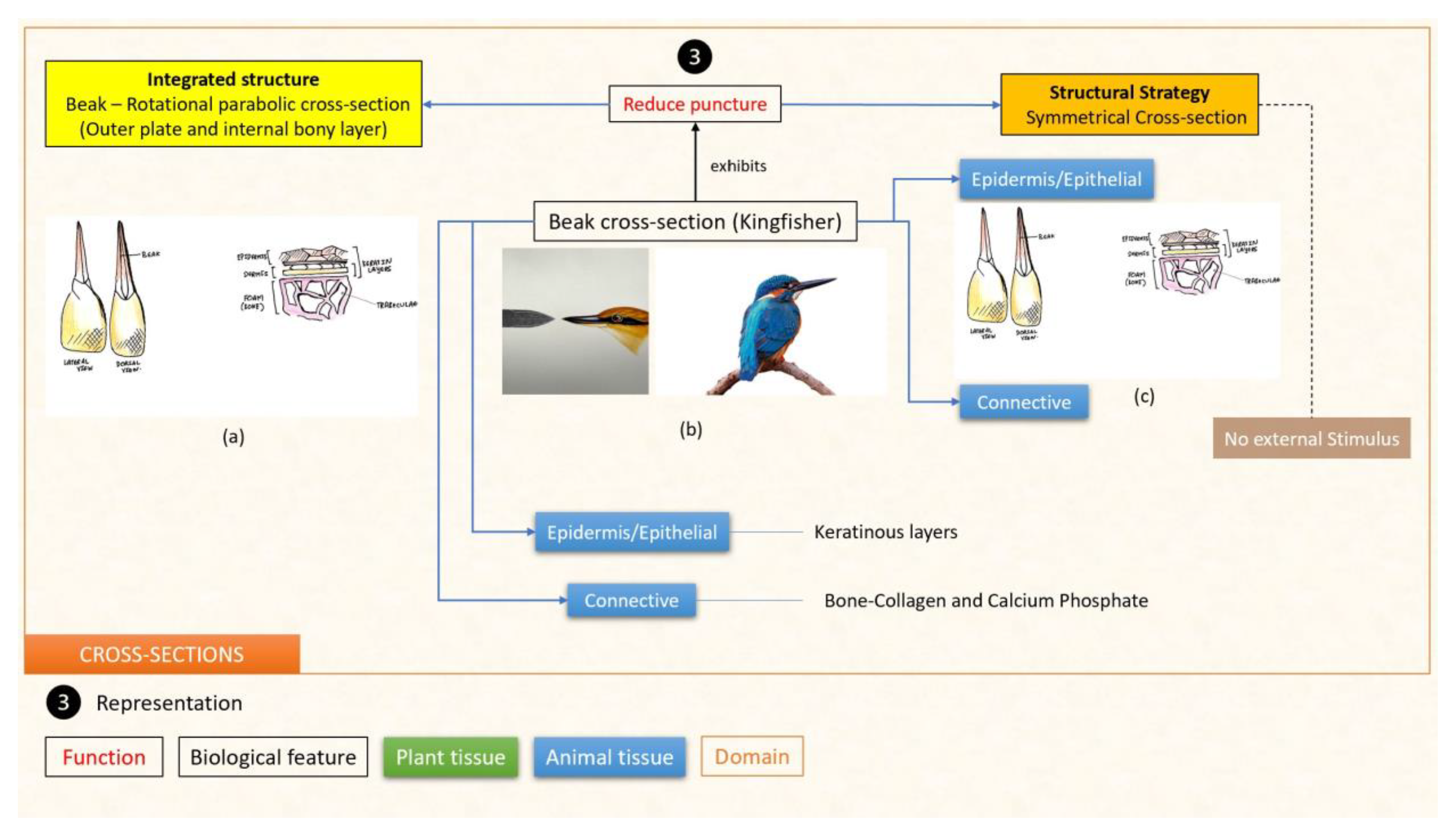
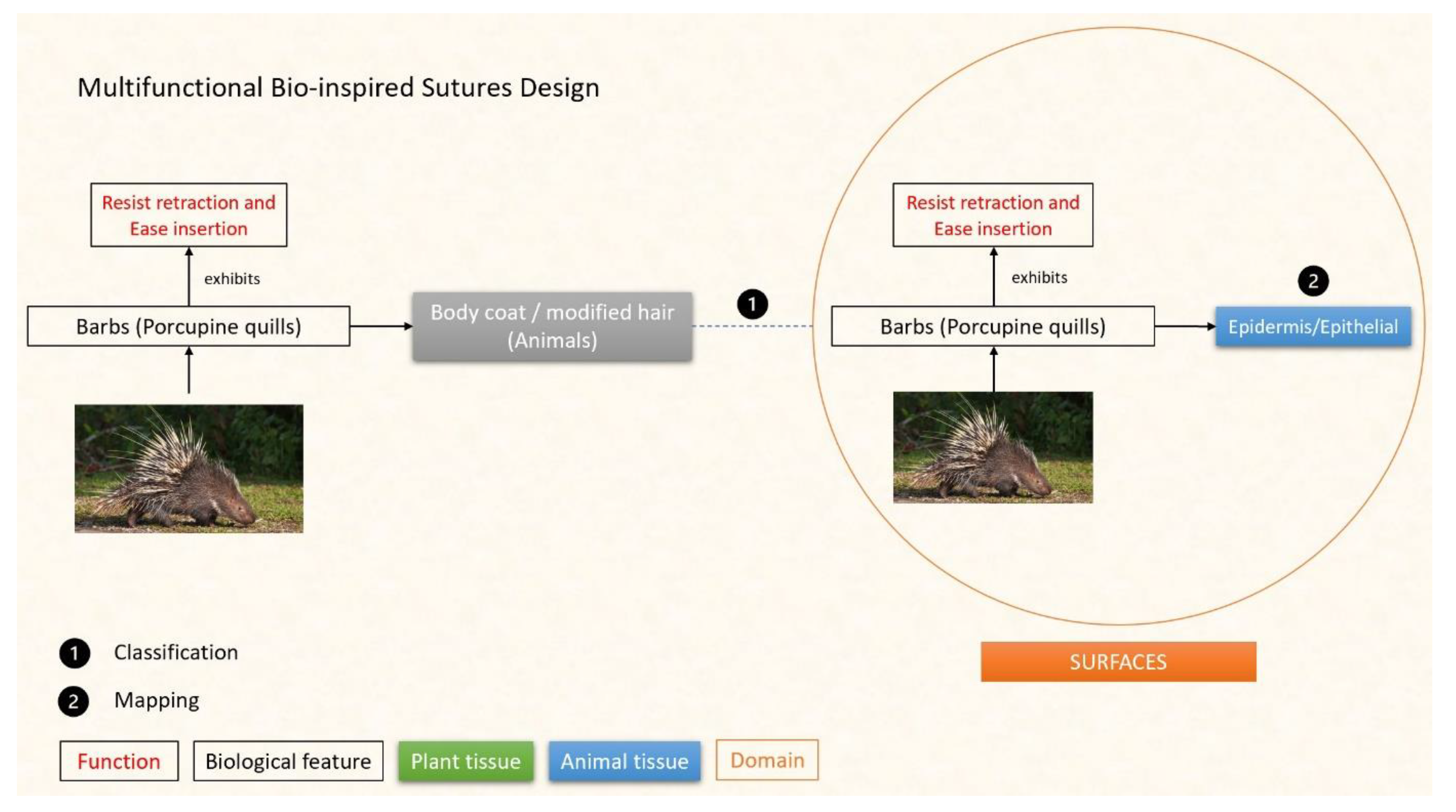
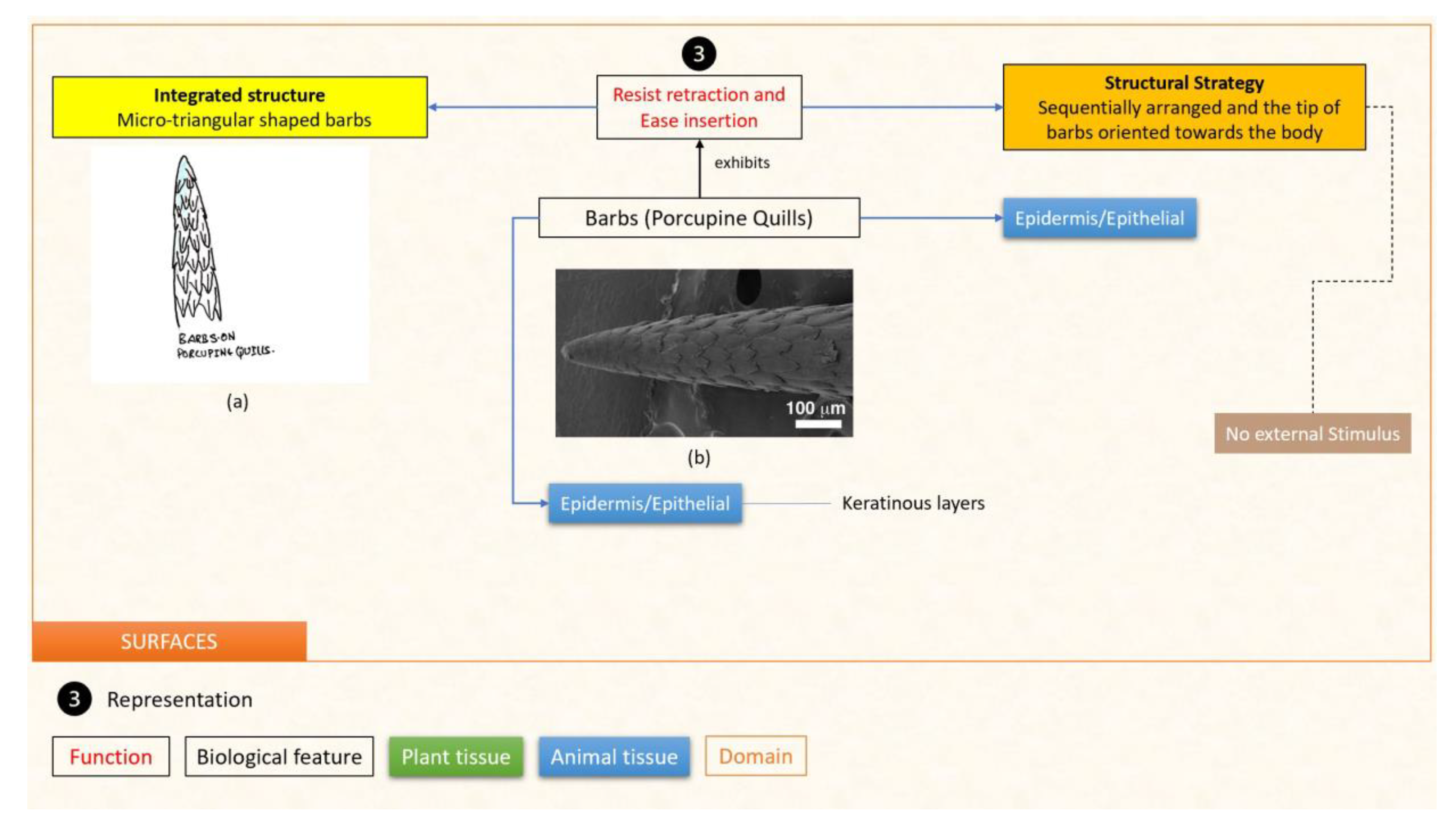
4.2. Multifunctional Effective Heat Transfer and Low-Pressure Drop
- (a)
- Classification: As shown in Figure 17, the camel turbinates cross-section with biological features characteristic of a cross-section of the body part (Nasal cartilage) is classified as belonging to the cross-section domain. Figure 18 shows the mapping of the camel turbinates to their respective tissue. Similarly, Figure 19 shows the micro/nano projections of the Namib Desert beetle with biological features characteristic of body/skin texture, classified as belonging to the surface domain.
- (b)
- Mapping: The classified biological features are mapped to the tissues from which they originate. The camel’s turbinate (nasal cartilage) is mapped to the connective tissue [64]. Similarly, the micro/nano projections of the Namib Desert beetle are mapped to the epicuticle/epidermis tissue [1]. Figure 18 shows the mapping and the materials of the tissue from which the biological feature is made. Mapping initiates and ensures the search for appropriate material selection for the new design that matches the properties of biological materials. As shown, nasal cartilage is made up of collagen, elastic fibers, and extracellular matrixes (ECM) [65]. Similarly, as shown in Figure 20, the micro bumps of the Namib Desert beetle arise due to the keratin layers of the skin. For this study, the structures are analyzed for convective heat transfer and the material aspects of the structure are omitted.
- (c)
- Representation: Figure 18 and Figure 20 represent the embodiment function of the camel turbinate structure (to transfer heat) as a combination of the integrated structure that is a labyrinth [64,66] and the structural strategy is the symmetry along the axis. Similarly, the embodiment function of the Namib Desert beetle’s micro bumps (to increase surface area and absorb water) is represented as a combination of the integrated structure; that is, its peaks are hydrophilic, its valleys are hydrophobic, and the structural strategy is the orientation of the micro bumps at 23 degrees to the ground [1].

4.3. Multifunctional Non-Pneumatic Tire Design
- (a)
- Classification: Figure 22 shows that snake scales with biological features characteristic of body/skin texture are classified as belonging to the surface domain. Figure 23 shows the mapping of the snake scales to their respective tissue. Similarly, Figure 24 shows the woodpecker’s foamy beak, with biological features characteristic of stochastic tessellation, is classified as belonging to the cellular-structure domain. Figure 25 shows the mapping of the woodpecker’s beak to its respective tissue. As shown in Figure 26, pomelo peel with biological features characteristic of stochastic tessellation is classified as a cellular structure.
- (b)
- Mapping: The classified biological features are mapped to the respective tissues from which they originate. The snake scales are mapped to the epidermis tissue containing keratin proteins [38]. Similarly, the foamy layer of the woodpecker’s beak is an inner bone layer, and is mapped to the connective tissue [47]. Likewise, the pomelo peel’s stochastic structure is denoted by the formation of vascular bundles by the parenchymatic tissue [46]. Figure 23 shows the materials of the tissue from which the biological feature is made. Mapping initiates and ensures the search for appropriate material selection for the new design that matches the properties of biological materials. As shown, the scale of a snake arises due to keratin layers. Similarly, as shown in Figure 25, the foamy layer is formed by bundles of collagen fibers [70]. Figure 27 shows that vascular bundles are made up of xylem and phloem (sieve tubes) [44]. For this study, structural analysis was performed to compare the deformation between the woodpecker’s foam and the pomelo peel’s foam, and the material aspect was omitted.
- (c)
- Representation: Figure 25 and Figure 27 show the embodiment function of the snake scales to manage friction is represented as a combination of the integrated structure that is microstructure (triangular) on the central ventral and side ventral scales and the structural strategy is the arrangement of the scales in caudal elevation [71]. Similarly, the woodpecker’s beak embodiment function (to absorb impact) is represented as a combination of the integrated structure that is the gradient foamy stochastic tessellations, and the structural strategy is the stochasticity of the foam [72]. Likewise, the embodiment function of the pomelo peel (to absorb impact) is represented as the combination of the integrated structure which is the porous structure and the structural strategy which is the arrangement of dense vascular bundles in a stochastic manner [46].
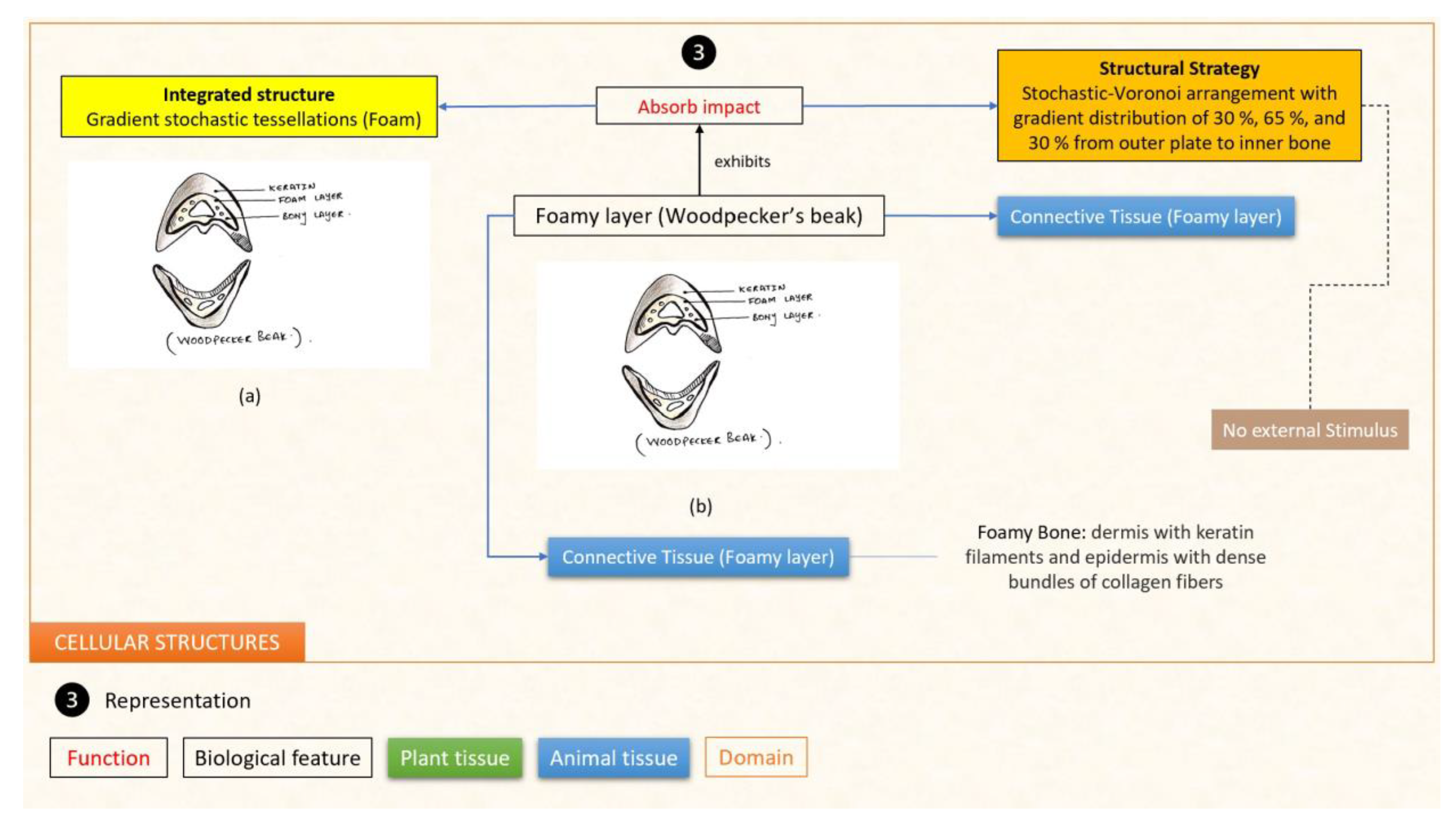
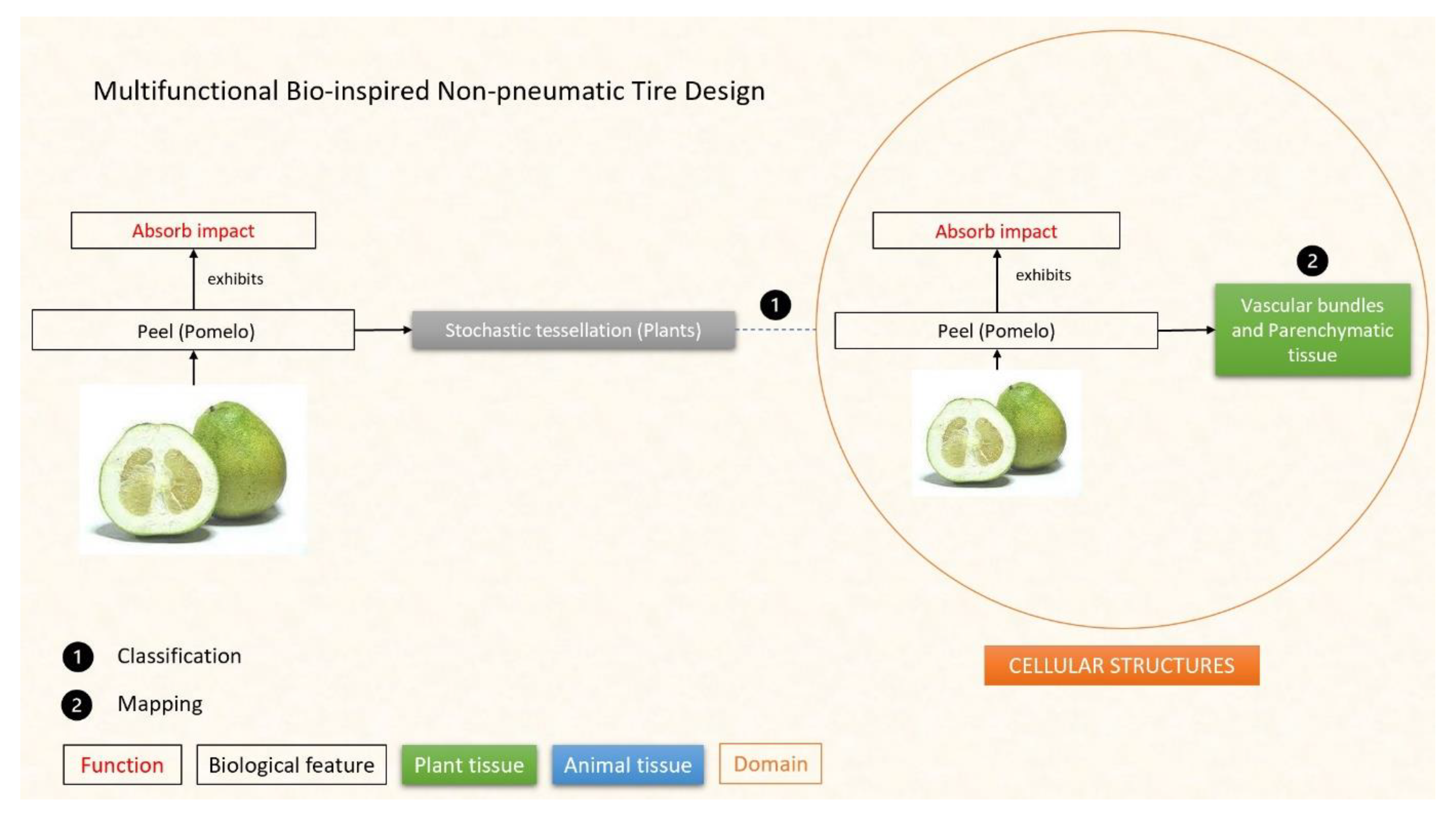

5. Conclusions
Author Contributions
Funding
Conflicts of Interest
References
- Guadarrama-Cetina, J.; Mongruel, A.; Medici, M.-G.; Baquero, E.; Parker, A.; Milimouk-Melnytchuk, I.; González-Viñas, W.; Beysens, D. Dew condensation on desert beetle skin. Eur. Phys. J. E 2014, 37, 109. [Google Scholar] [CrossRef]
- San Ha, N.; Lu, G. A review of recent research on bio-inspired structures and materials for energy absorption applications. Compos. Part B Eng. 2020, 181, 107496. [Google Scholar]
- Vattam, S.; Wiltgen, B.; Helms, M.; Goel, A.; Yen, J. Fostering Creativity in and through Biologically Inspired Design. In Design Creativity 2010; Springer: Dane, WI, USA, 2011. [Google Scholar]
- Helms, M.; Vattam, S.S.; Goel, A.K. Biologically inspired design: Process and products. Des. Stud. 2009, 30, 606–622. [Google Scholar] [CrossRef]
- Ceschin, F.; Gaziulusoy, I. Evolution of design for sustainability: From product design to design for system innovations and transitions. Des. Stud. 2016, 47, 118–163. [Google Scholar] [CrossRef]
- Goel, A.K.; Bras, B.; Helms, M.; Rugaber, S.; Tovey, C.; Vattam, S.; Weissburg, M.; Wiltgen, B.; Yen, J. Design patterns and cross-domain analogies in biologically inspired sustainable design. In Proceedings of the 2011 AAAI Spring Symposium Series, Stanford, CA, USA, 21–23 March 2011. [Google Scholar]
- Fish, F.E.; Beneski, J.T. Evolution and bio-inspired design: Natural limitations. In Biologically Inspired Design; Springer: Berlin/Heidelberg, Germany, 2014; pp. 287–312. [Google Scholar]
- Ren, L.; Liang, Y. Biological couplings: Classification and characteristic rules. Sci. China Ser. E Technol. Sci. 2009, 52, 2791–2800. [Google Scholar] [CrossRef]
- Ren, L.; Liang, Y. Biological couplings: Function, characteristics and implementation mode. Sci. China Technol. Sci. 2010, 53, 379–387. [Google Scholar] [CrossRef]
- Du Plessis, A.; Broeckhoven, C.; Yadroitsava, I.; Yadroitsev, I.; Hands, C.H.; Kunju, R.; Bhate, D. Beautiful and functional: A review of biomimetic design in additive manufacturing. Addit. Manuf. 2019, 27, 408–427. [Google Scholar] [CrossRef]
- Chen, P.-Y.; McKittrick, J.; Meyers, M.A. Biological materials: Functional adaptations and bioinspired designs. Prog. Mater. Sci. 2012, 57, 1492–1704. [Google Scholar] [CrossRef]
- Han, Z.; Mu, Z.; Yin, W.; Li, W.; Niu, S.; Zhang, J.; Ren, L. Biomimetic multifunctional surfaces inspired from animals. Adv. Colloid Interface Sci. 2016, 234, 27–50. [Google Scholar] [CrossRef]
- Zhang, M.; Feng, S.; Wang, L.; Zheng, Y. Lotus effect in wetting and self-cleaning. Biotribology 2016, 5, 31–43. [Google Scholar] [CrossRef]
- Bhate, D.; Penick, C.A.; Ferry, L.A.; Lee, C. Classification and selection of cellular materials in mechanical design: Engineering and biomimetic approaches. Designs 2019, 3, 19. [Google Scholar] [CrossRef] [Green Version]
- Badarnah, L.; Kadri, U. A methodology for the generation of biomimetic design concepts. Archit. Sci. Rev. 2015, 58, 120–133. [Google Scholar] [CrossRef]
- Bhasin, D.; McAdams, D.A.; Layton, A. A product architecture-based tool for bioinspired function-sharing. J. Mech. Des. 2021, 143, 081401. [Google Scholar] [CrossRef]
- Altshuller, G.; Al’tov, G.; Altov, H. And Suddenly the Inventor Appeared: Triz, the Theory of Inventive Problem Solving; Technical Innovation Center, Inc.: Worcester, MA, USA, 1996. [Google Scholar]
- Svendsen, N.W.; Lenau, T.A. Approaches to analyzing multi-functional problems. In Proceedings of the DS 101: Proceedings of NordDesign 2020, Lyngby, Denmark, 12–14 August 2020; pp. 1–12. [Google Scholar]
- Tan, R.; Liu, W.; Cao, G.; Shi, Y. Creative design inspired by biological knowledge: Technologies and methods. Front. Mech. Eng. 2019, 14, 1–14. [Google Scholar] [CrossRef] [Green Version]
- Zhang, P.; Li, X.; Nie, Z.; Yu, F.; Liu, W. A Trimming Design Method Based on Bio-Inspired Design for System Innovation. Appl. Sci. 2021, 11, 4060. [Google Scholar] [CrossRef]
- Tan, N.; Sun, Z.; Mohan, R.E.; Brahmananthan, N.; Venkataraman, S.; Sosa, R.; Wood, K. A system-of-systems bio-inspired design process: Conceptual design and physical prototype of a reconfigurable robot capable of multi-modal locomotion. Front. Neurorobot. 2019, 13, 78. [Google Scholar] [CrossRef]
- Vattam, S.S.; Helms, M.E.; Goel, A.K. Compound analogical design: Interaction between problem decomposition and analogical transfer in biologically inspired design. In Design Computing and Cognition’08; Springer: Berlin/Heidelberg, Germany, 2008; pp. 377–396. [Google Scholar]
- Velivela, P.T.; Zhao, Y.F. A Comparative Analysis of the State-of-the-Art Methods for Multifunctional Bio-Inspired Design and an Introduction to Domain Integrated Design (DID). Designs 2022, 6, 120. [Google Scholar] [CrossRef]
- Velivela, P.T.; Letov, N.; Liu, Y.; Zhao, Y.F. Application of Domain Integrated Design Methodology for Bio-Inspired Design-A Case Study of Suture Pin Design. Proc. Des. Soc. 2021, 1, 487–496. [Google Scholar] [CrossRef]
- Liu, Z.; Jiao, D.; Weng, Z.; Zhang, Z. Structure and mechanical behaviors of protective armored pangolin scales and effects of hydration and orientation. J. Mech. Behav. Biomed. Mater. 2016, 56, 165–174. [Google Scholar] [CrossRef]
- Ingrole, A.; Aguirre, T.G.; Fuller, L.; Donahue, S.W. Bioinspired energy absorbing material designs using additive manufacturing. J. Mech. Behav. Biomed. Mater. 2021, 119, 104518. [Google Scholar] [CrossRef]
- Chowdhury, H.; Islam, R.; Hussein, M.; Zaid, M.; Loganathan, B.; Alam, F. Design of an energy efficient car by biomimicry of a boxfish. Energy Procedia 2019, 160, 40–44. [Google Scholar] [CrossRef]
- McKeag, T. Auspicious Designs. In Zygote Quarterly Summer 2012; ISSUU: Palo Alto, CA, USA, 2012; ISSN 1927-8314. [Google Scholar]
- Ezemba, J.; Layton, A. Bio-Inspired Avenues for Advancing Brain Injury Prevention. J. Mech. Des. 2022, 144, 121403. [Google Scholar] [CrossRef]
- Seki, Y.; Bodde, S.G.; Meyers, M.A. Toucan and hornbill beaks: A comparative study. Acta Biomater. 2010, 6, 331–343. [Google Scholar] [CrossRef]
- Marshall, W.F. Origins of cellular geometry. BMC Biol. 2011, 9, 57. [Google Scholar] [CrossRef] [Green Version]
- Langille, R. Human Tissues and Systems. NSCC Hum. Biol. 2020, 3, 32–34. [Google Scholar]
- Crang, R.; Lyons-Sobaski, S.; Wise, R. Parenchyma, collenchyma, and sclerenchyma. In Plant Anatomy; Springer: Berlin/Heidelberg, Germany, 2018; pp. 181–213. [Google Scholar]
- Rogers, A.W. Cells and Tissues; Academic Press: London, UK; New York, NY, USA, 1983. [Google Scholar]
- Willocx, M.; Duflou, J. Combining bio-inspiration and ecodesign. Procedia CIRP 2021, 98, 595–600. [Google Scholar] [CrossRef]
- Habib, M.K.; Nagata, F. Bioinspired design: Creativity and sustainability. In Proceedings of the 2019 20th International Conference on Research and Education in Mechatronics (REM), Wels, Austria, 23–24 May 2019; pp. 1–5. [Google Scholar]
- Ensikat, H.J.; Ditsche-Kuru, P.; Neinhuis, C.; Barthlott, W. Superhydrophobicity in perfection: The outstanding properties of the lotus leaf. Beilstein J. Nanotechnol. 2011, 2, 152–161. [Google Scholar] [CrossRef] [Green Version]
- Wang, B.; Yang, W.; McKittrick, J.; Meyers, M.A. Keratin: Structure, mechanical properties, occurrence in biological organisms, and efforts at bioinspiration. Prog. Mater. Sci. 2016, 76, 229–318. [Google Scholar] [CrossRef] [Green Version]
- Seki, Y. Structure and Mechanical Behavior of Bird Beaks; University of California: San Diego, CA, USA, 2009. [Google Scholar]
- Luo, Y.; Yuan, L.; Li, J.; Wang, J. Boundary layer drag reduction research hypotheses derived from bio-inspired surface and recent advanced applications. Micron 2015, 79, 59–73. [Google Scholar] [CrossRef] [PubMed]
- Tiner, C.; Bapat, S.; Nath, S.D.; Atre, S.V.; Malshe, A. Exploring convergence of snake-skin-inspired texture designs and additive manufacturing for mechanical traction. Procedia Manuf. 2019, 34, 640–646. [Google Scholar] [CrossRef]
- Wilt, F.H.; Killian, C.E.; Livingston, B.T. Development of calcareous skeletal elements in invertebrates. Differ. Rev. 2003, 71, 237–250. [Google Scholar] [CrossRef]
- Alibardi, L. Cell biology of adhesive setae in gecko lizards. Zoology 2009, 112, 403–424. [Google Scholar] [CrossRef] [PubMed]
- Jung, J.H.; Park, C.M. Vascular development in plants: Specification of xylem and phloem tissues. J. Plant Biol. 2007, 50, 301–305. [Google Scholar] [CrossRef]
- Zhang, W.; Yin, S.; Yu, T.; Xu, J. Crushing resistance and energy absorption of pomelo peel inspired hierarchical honeycomb. Int. J. Impact Eng. 2019, 125, 163–172. [Google Scholar] [CrossRef]
- Bührig-Polaczek, A.; Fleck, C.; Speck, T.; Schüler, P.; Fischer, S.; Caliaro, M.; Thielen, M. Biomimetic cellular metals—Using hierarchical structuring for energy absorption. Bioinspir. Biomim. 2016, 11, 045002. [Google Scholar] [CrossRef]
- Rico-Guevara, A.; Sustaita, D.; Gussekloo, S.; Olsen, A.; Bright, J.; Corbin, C.; Dudley, R. Feeding in birds: Thriving in terrestrial, aquatic, and aerial niches. In Feeding in Vertebrates; Springer: Berlin/Heidelberg, Germany, 2019; pp. 643–693. [Google Scholar]
- Trotta, M.G. Bio-inspired design methodology. Int. J. Inf. Sci. 2011, 1, 1–11. [Google Scholar] [CrossRef]
- Helfman Cohen, Y.; Reich, Y.; Greenberg, S. Biomimetics: Structure–function patterns approach. J. Mech. Des. 2014, 136, 111108. [Google Scholar] [CrossRef]
- Yu, C.; Liu, M.; Zhang, C.; Yan, H.; Zhang, M.; Wu, Q.; Liu, M.; Jiang, L. Bio-inspired drag reduction: From nature organisms to artificial functional surfaces. Giant 2020, 2, 100017. [Google Scholar] [CrossRef]
- Lienhard, J.; Schleicher, S.; Knippers, J. Bio-inspired, flexible structures and materials. In Biotechnologies and Biomimetics for Civil Engineering; Springer: Berlin/Heidelberg, Germany, 2015; pp. 275–296. [Google Scholar]
- Gao, X. Antifogging Properties in Mosquito Eyes. In Encyclopedia of Nanotechnology; Bhushan, B., Ed.; Springer: Dordrecht, The Netherlands, 2012; pp. 117–121. [Google Scholar] [CrossRef]
- Deng, Y.-M.; Britton, G.; Tor, S. A design perspective of mechanical function and its object-oriented representation scheme. Eng. Comput. 1998, 14, 309–320. [Google Scholar] [CrossRef]
- Keshwani, S.; Chakrabarti, A. Towards automatic classification of description of analogies into SAPPhIRE constructs. In Research into Design for Communities, Proceedings of ICoRD 2017, Guwahati, India, 9–11 January 2017; Springer: Singapore, 2017; Volume 2, pp. 643–655. [Google Scholar]
- Goel, A.K.; Rugaber, S.; Vattam, S. Structure, behavior, and function of complex systems: The structure, behavior, and function modeling language. Ai Edam 2009, 23, 23–35. [Google Scholar] [CrossRef]
- Zhang, W.; Tor, S.B.; Britton, G.; Deng, Y. Functional Design of Mechanical Products Based on Behavior-Driven Function-Environment-Structure Modeling Framework. 2002. Available online: https://dspace.mit.edu/handle/1721.1/4031 (accessed on 15 April 2023).
- Cowan, F.S.; Allen, J.K.; Mistree, F. Functional modelling in engineering design: A perspectival approach featuring living systems theory. Syst. Res. Behav. Sci. Off. J. Int. Fed. Syst. Res. 2006, 23, 365–381. [Google Scholar] [CrossRef]
- Han, Z.; Zhu, B.; Yang, M.; Niu, S.; Song, H.; Zhang, J. The effect of the micro-structures on the scorpion surface for improving the anti-erosion performance. Surf. Coat. Technol. 2017, 313, 143–150. [Google Scholar] [CrossRef]
- Chou, S.; Overfelt, R. Tensile deformation and failure of North American porcupine quills. Mater. Sci. Eng. C 2011, 31, 1729–1736. [Google Scholar] [CrossRef]
- Koons, G.L.; Diba, M.; Mikos, A.G. Materials design for bone-tissue engineering. Nat. Rev. Mater. 2020, 5, 584–603. [Google Scholar] [CrossRef]
- Karp, J.M. Porcupine-Inspired Needles. 2014. Available online: https://www.karplab.net/portfolio-item/porcupine-inspired-needles (accessed on 2 July 2020).
- Crandell, K.; Howe, R.; Falkingham, P. Repeated evolution of drag reduction at the air–water interface in diving kingfishers. J. R. Soc. Interface 2019, 16, 20190125. [Google Scholar] [CrossRef] [Green Version]
- Shivangi Sarabhai, P.T.V.; Zhao, Y.F.; Sanchez, F.; Kibsey, M. Comparative study of the flow and heat characteristics of non-stochastic lattice and bio-inspired multi-scale structures for gas turbine engine applications. In Proceedings of the ASME Turbo Expo 2023 Turbomachinery Technical Conference and Exposition (GT2023), Boston, MA, USA, 26–30 June 2023. [Google Scholar]
- Alsafy, M.A.; El-gendy, S.A.; Abumandour, M.M. Computed tomography and gross anatomical studies on the head of one-humped camel (Camelus dromedarius). Anat. Rec. 2014, 297, 630–642. [Google Scholar] [CrossRef]
- Parvizi, J. High Yield Orthopaedics E-Book; Elsevier Health Sciences: Amsterdam, The Netherlands, 2010. [Google Scholar]
- Shahda, M.M.; Abd Elhafeez, M.M.; El Mokadem, A.A. Camel’s nose strategy: New innovative architectural application for desert buildings. Sol. Energy 2018, 176, 725–741. [Google Scholar] [CrossRef]
- Sun, J.; Bhushan, B. Structure and mechanical properties of beetle wings: A review. Rsc Adv. 2012, 2, 12606–12623. [Google Scholar] [CrossRef]
- Abbas, A.; Zhang, C.; Asad, M.; Waqas, A.; Khatoon, A.; Hussain, S.; Mir, S.H. Recent developments in artificial super-wettable surfaces based on bioinspired polymeric materials for biomedical applications. Polymers 2022, 14, 238. [Google Scholar] [CrossRef]
- Velivela, P.; Letov, N.; Kong, L.; Zhao, Y. A case study of multifunctional non-pneumatic tire design for the validation of meta-level design parameter in domain integrated design (did) metHOD. Proc. Design Soc. 2023, 3, 39–48. [Google Scholar] [CrossRef]
- Zhang, W.; Xu, J.; Yu, T. Dynamic behaviors of bio-inspired structures: Design, mechanisms, and models. Eng. Struct. 2022, 265, 114490. [Google Scholar] [CrossRef]
- Klein, M.-C.G.; Gorb, S.N. Epidermis architecture and material properties of the skin of four snake species. J. R. Soc. Interface 2012, 9, 3140–3155. [Google Scholar] [CrossRef] [Green Version]
- Wang, L.; Lu, S.; Liu, X.; Niu, X.; Wang, C.; Ni, Y.; Zhao, M.; Feng, C.; Zhang, M.; Fan, Y. Biomechanism of impact resistance in the woodpecker’s head and its application. Sci. China Life Sci. 2013, 56, 715–719. [Google Scholar] [CrossRef] [PubMed] [Green Version]
- Lee, N.; Horstemeyer, M.; Rhee, H.; Nabors, B.; Liao, J.; Williams, L.N. Hierarchical multiscale structure–property relationships of the red-bellied woodpecker (Melanerpes carolinus) beak. J. R. Soc. Interface 2014, 11, 20140274. [Google Scholar] [CrossRef] [PubMed] [Green Version]
- Yang, B.; Chen, W.; Xin, R.; Zhou, X.; Tan, D.; Ding, C.; Wu, Y.; Yin, L.; Chen, C.; Wang, S. Pomelo peel-inspired 3D-printed porous structure for efficient absorption of compressive strain energy. J. Bionic Eng. 2022, 19, 448–457. [Google Scholar] [CrossRef]

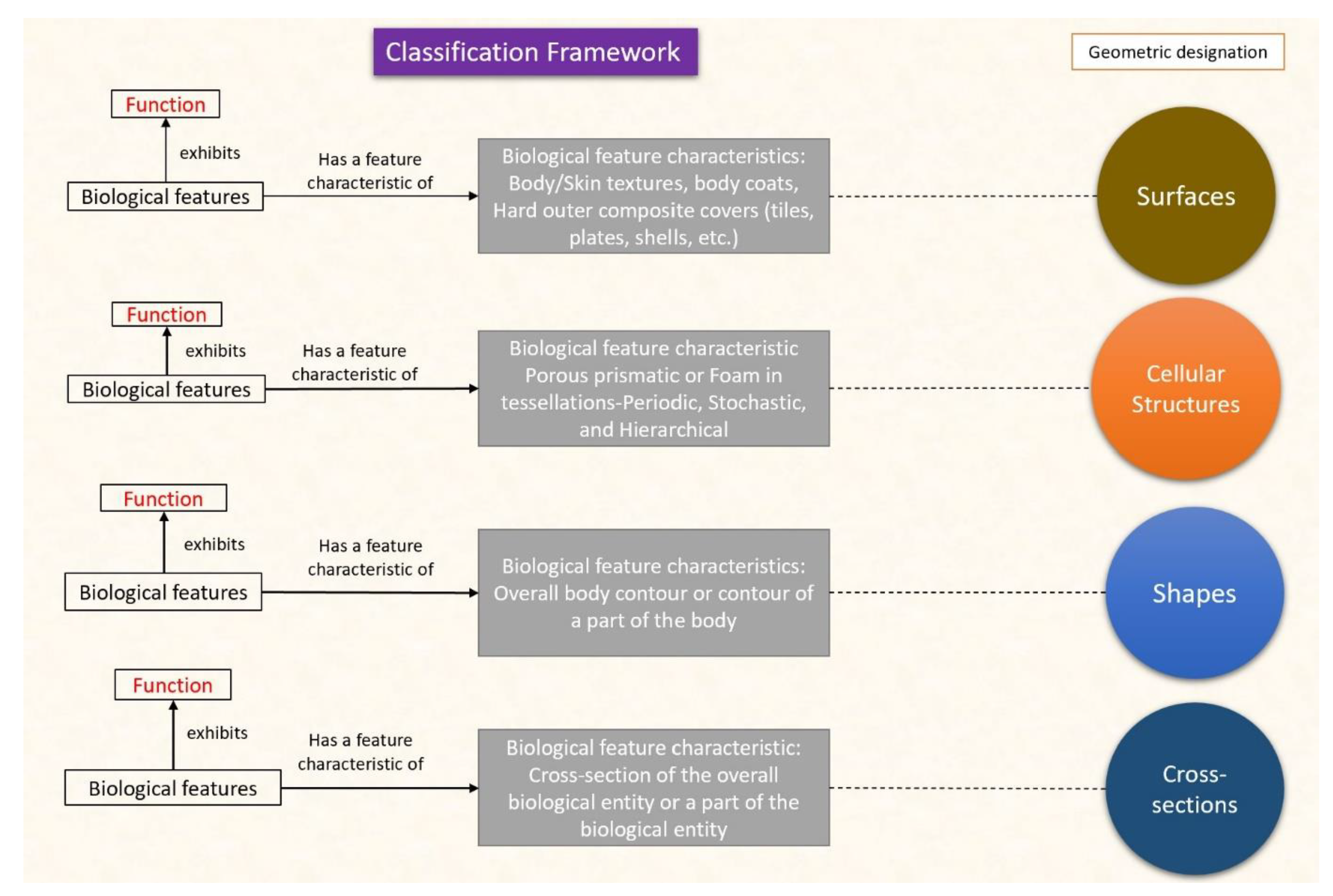
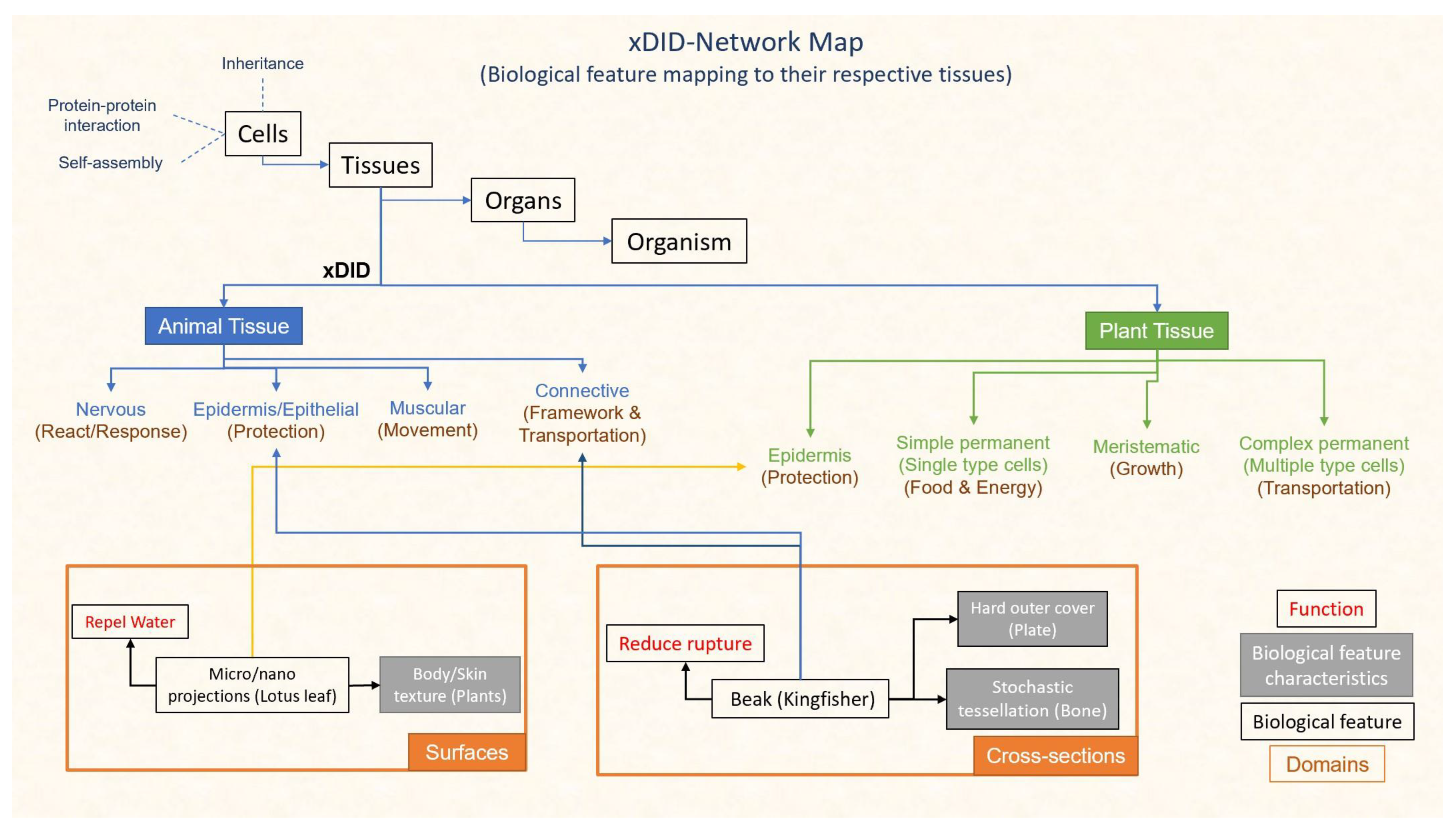


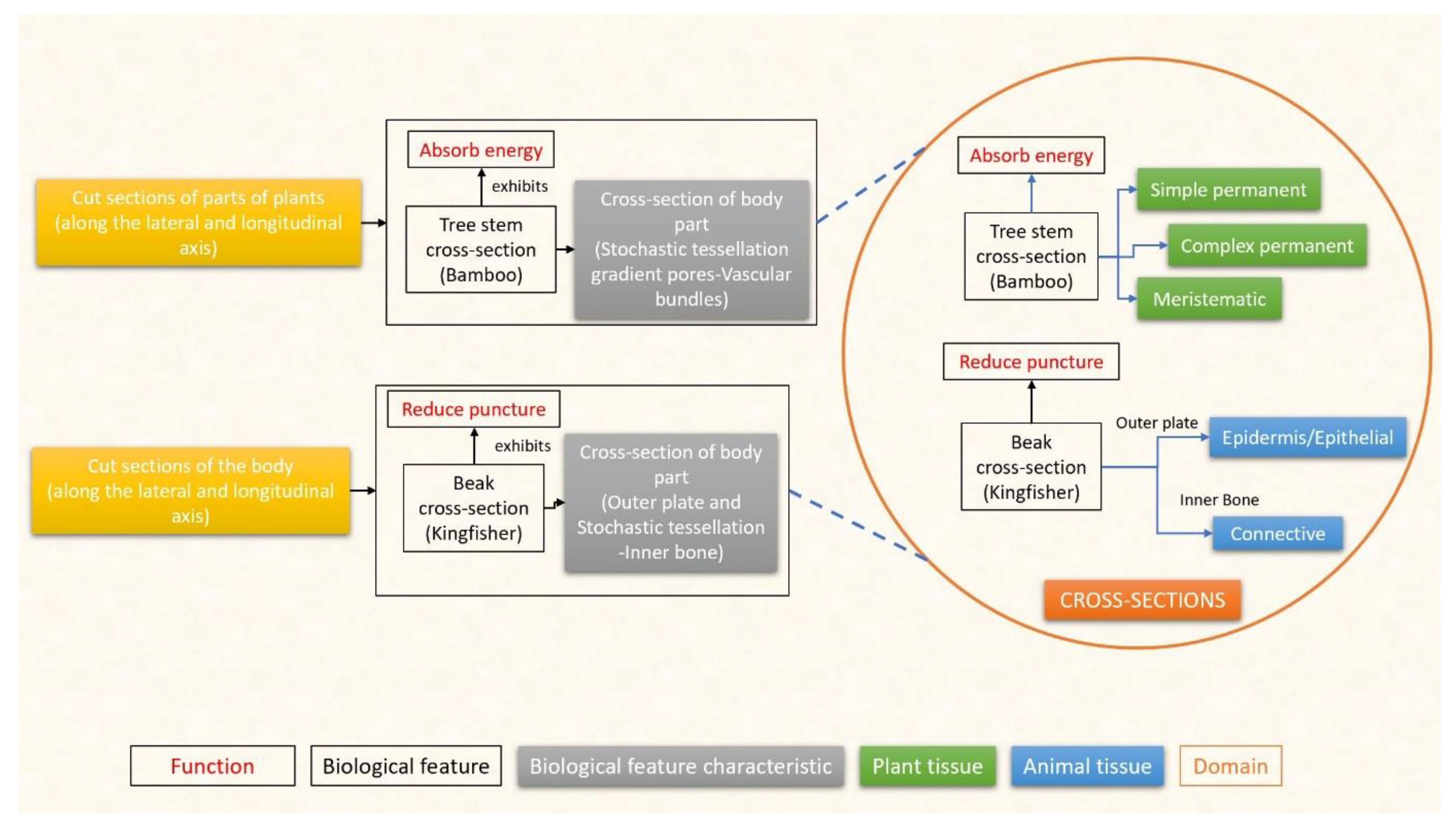


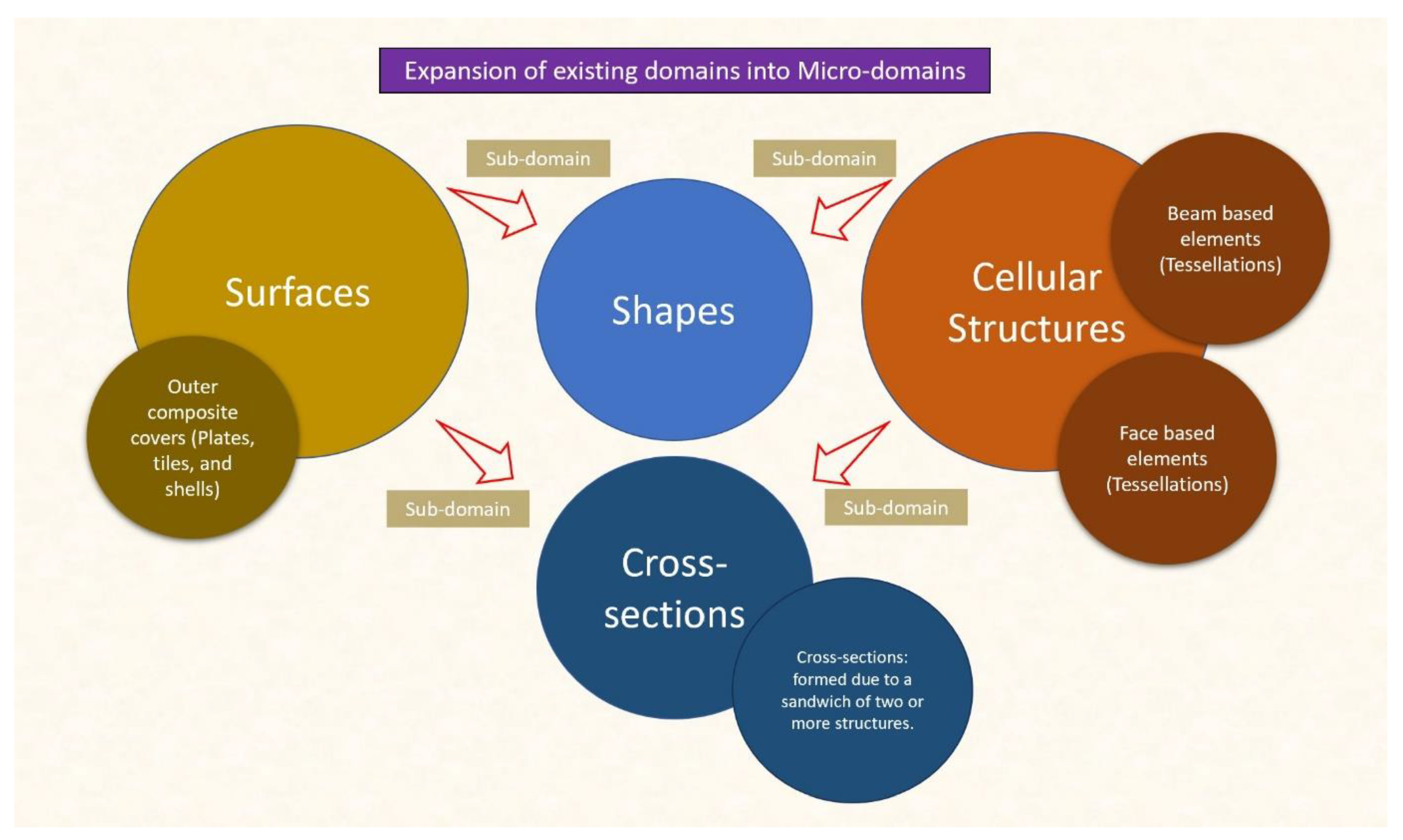
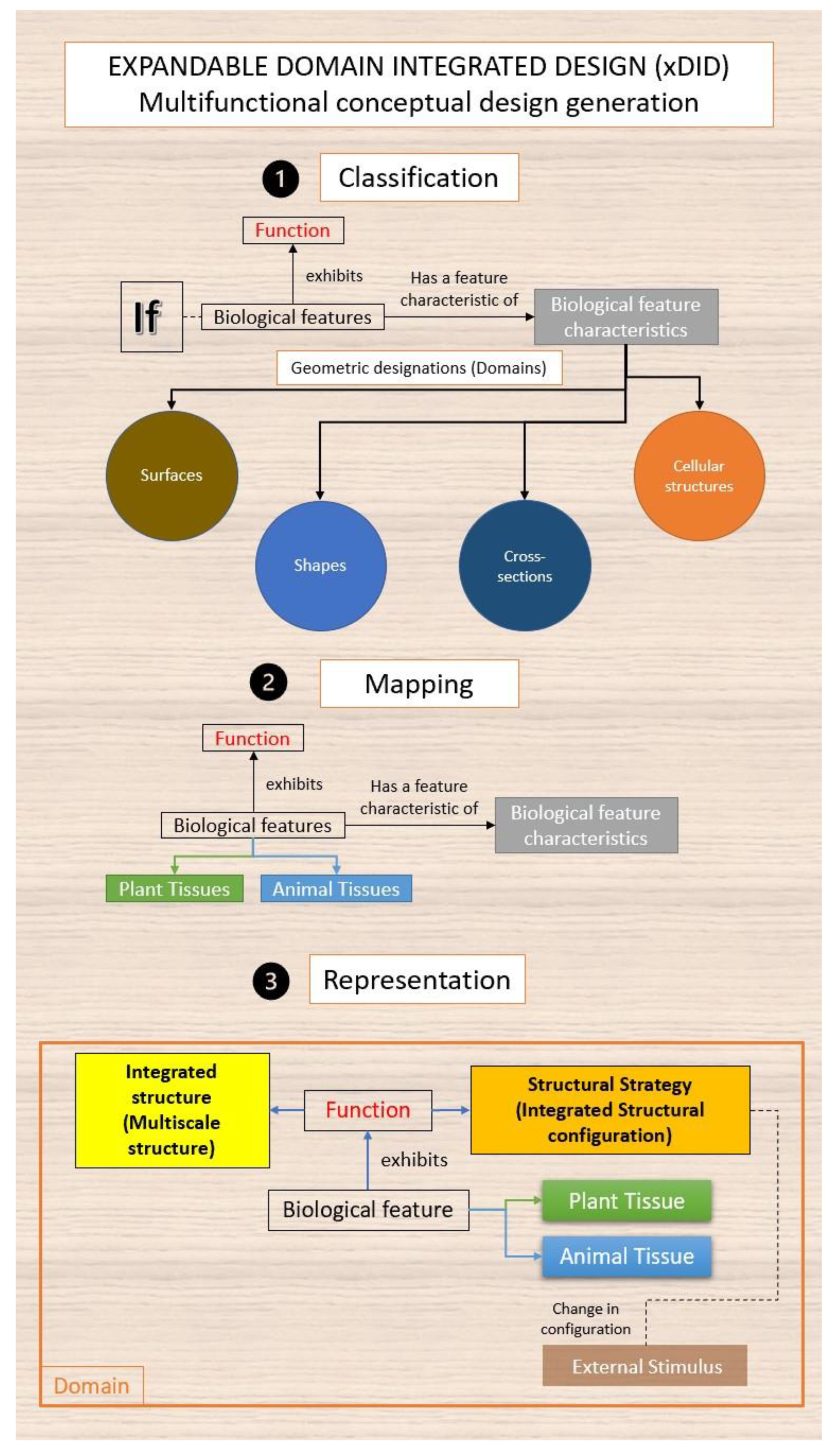

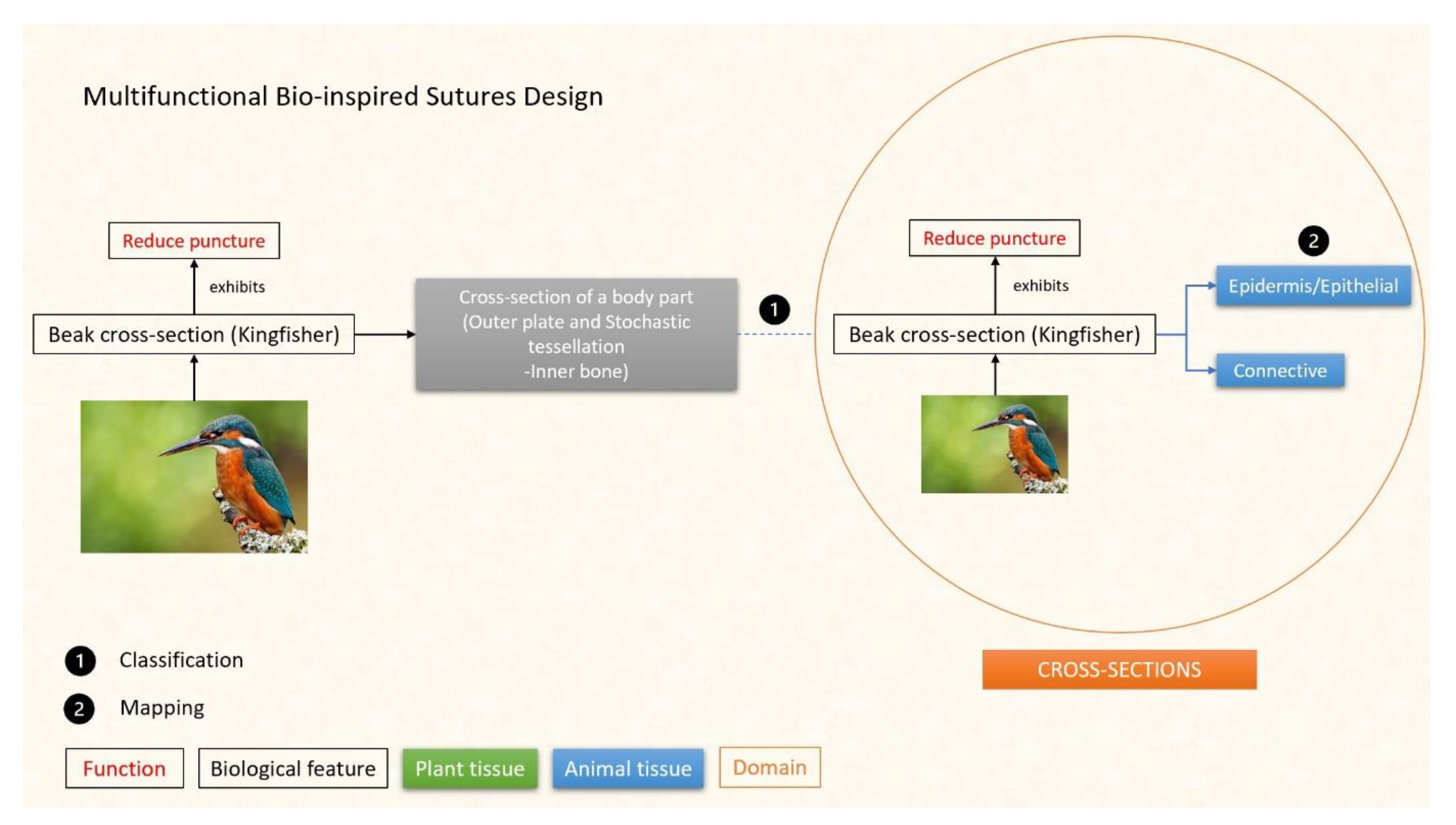
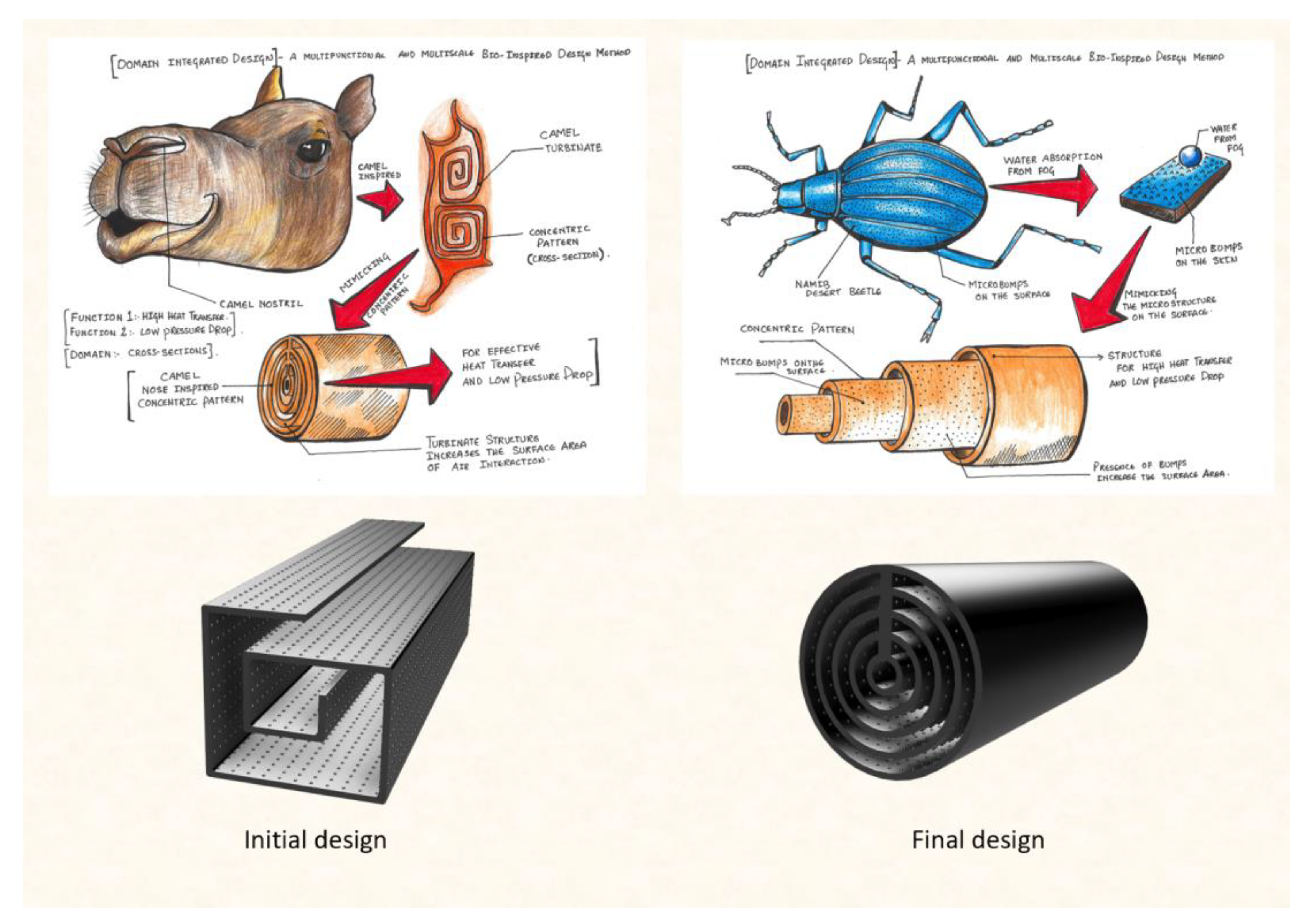
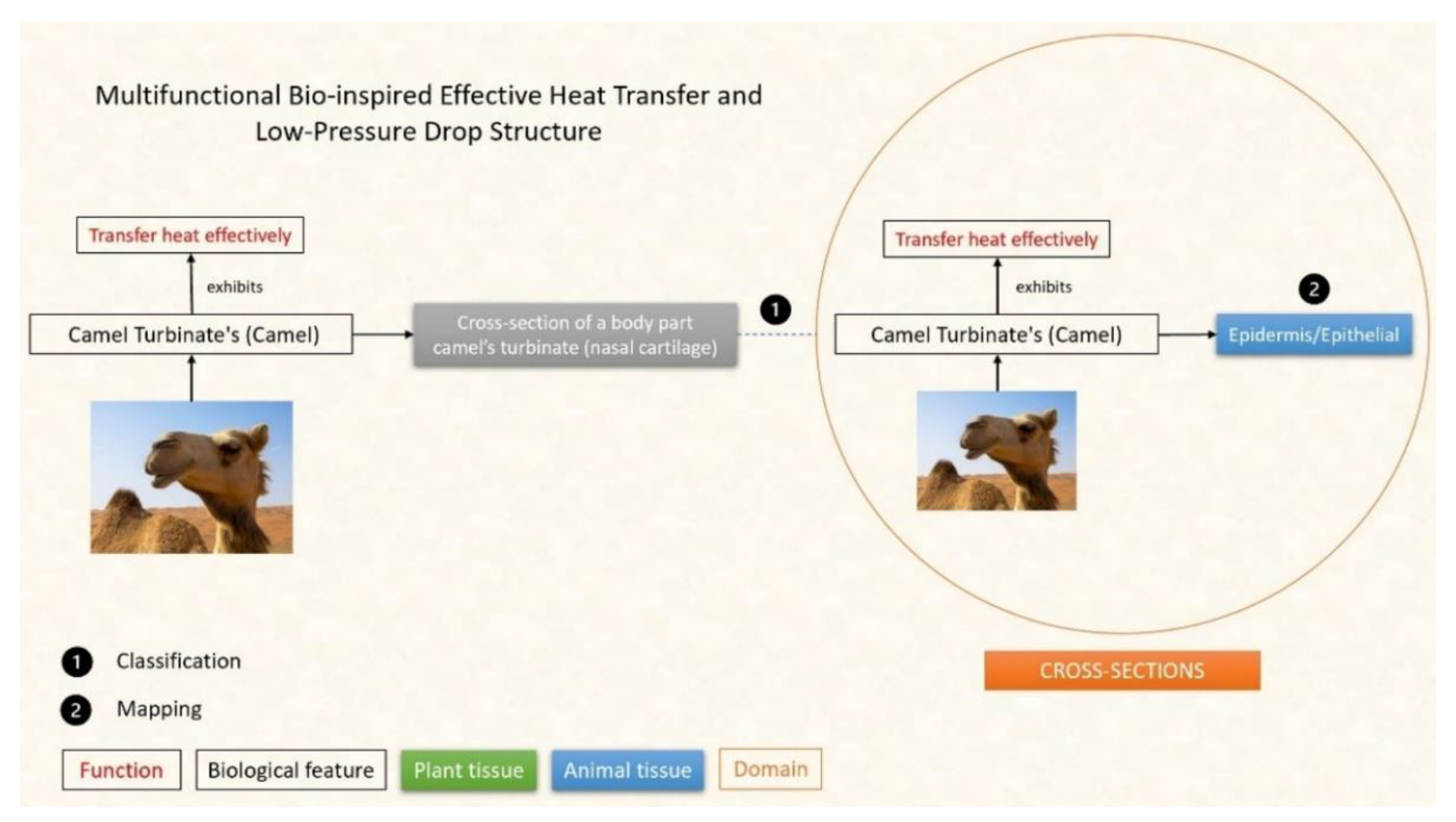
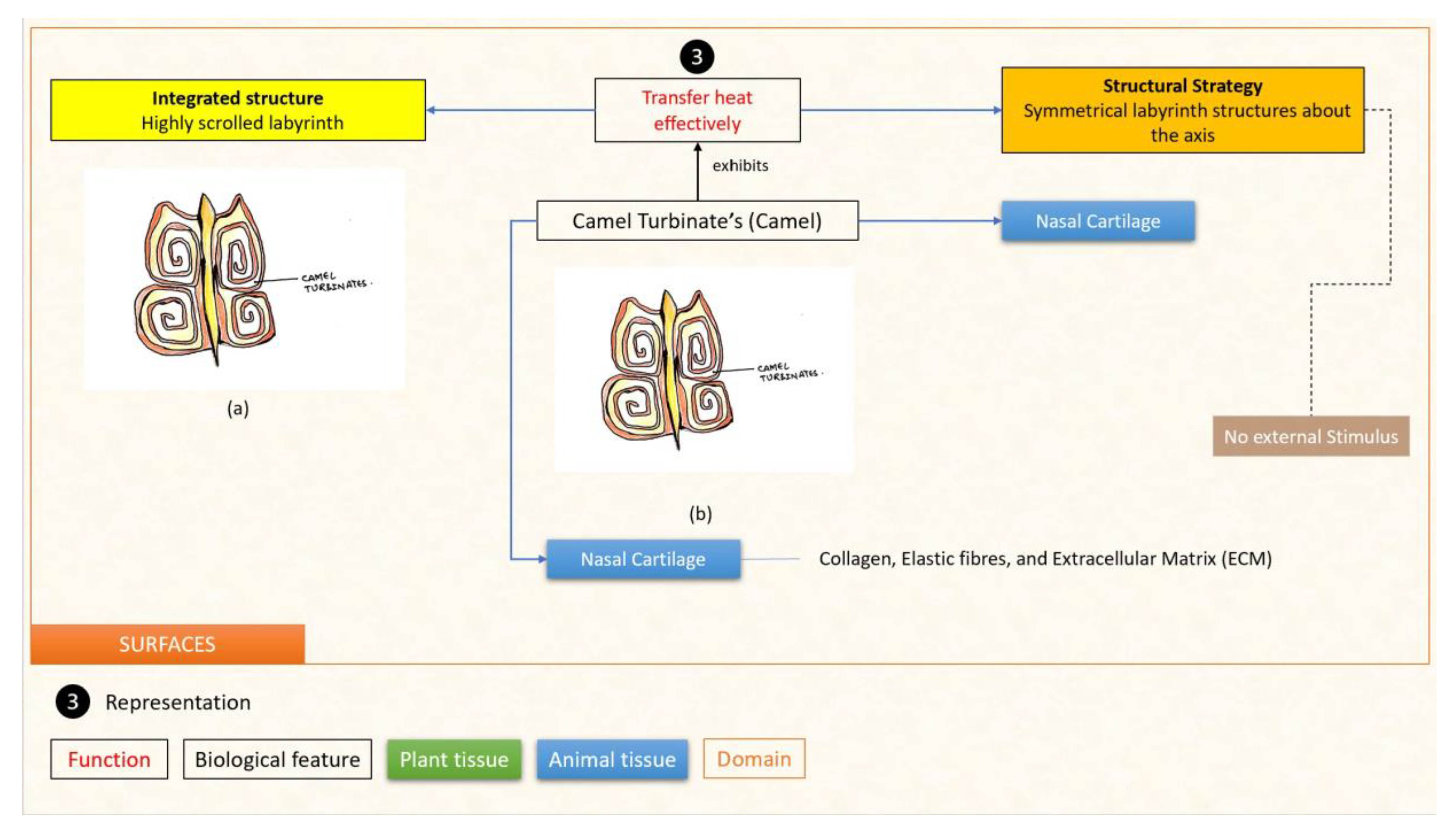
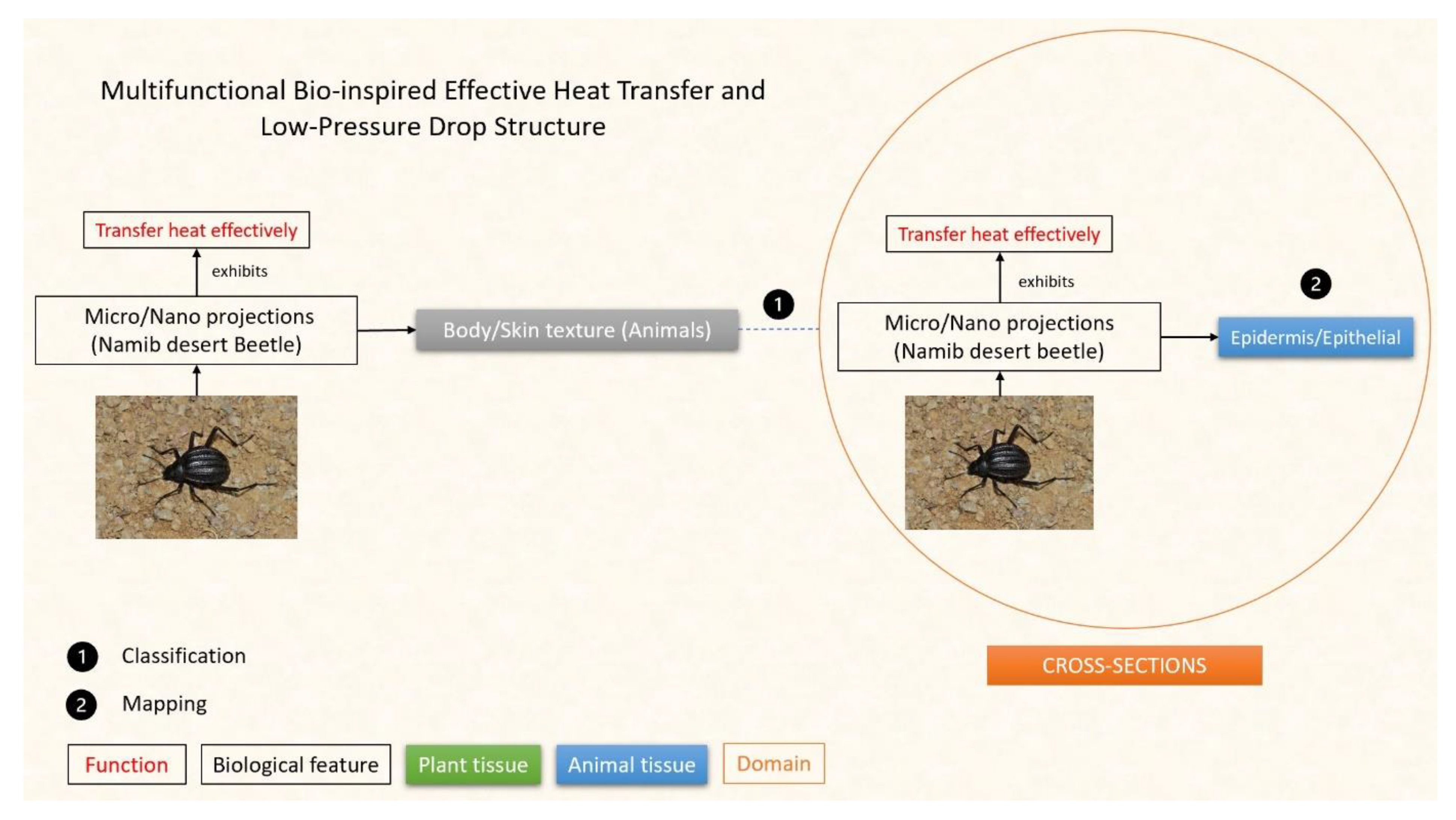

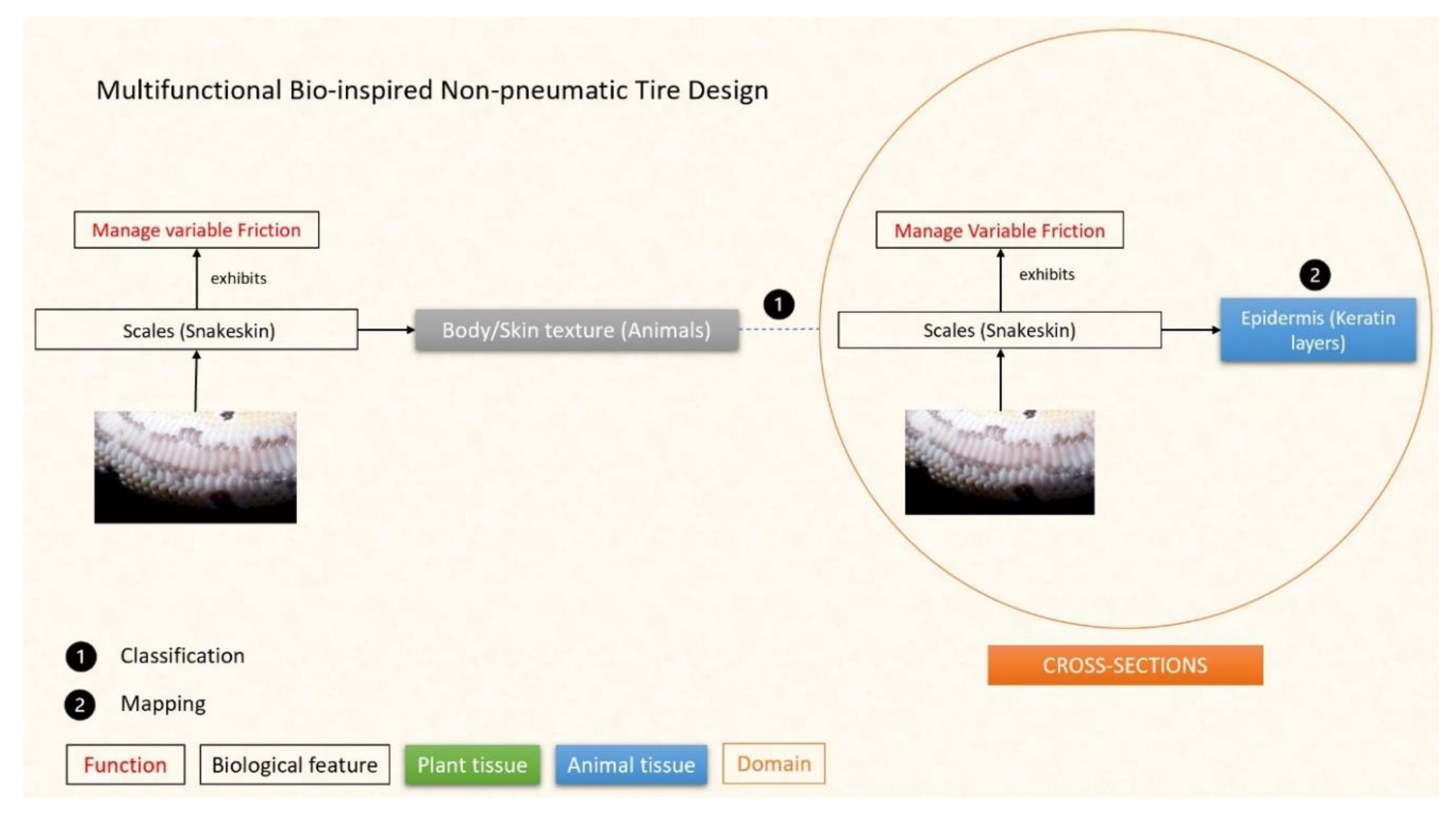
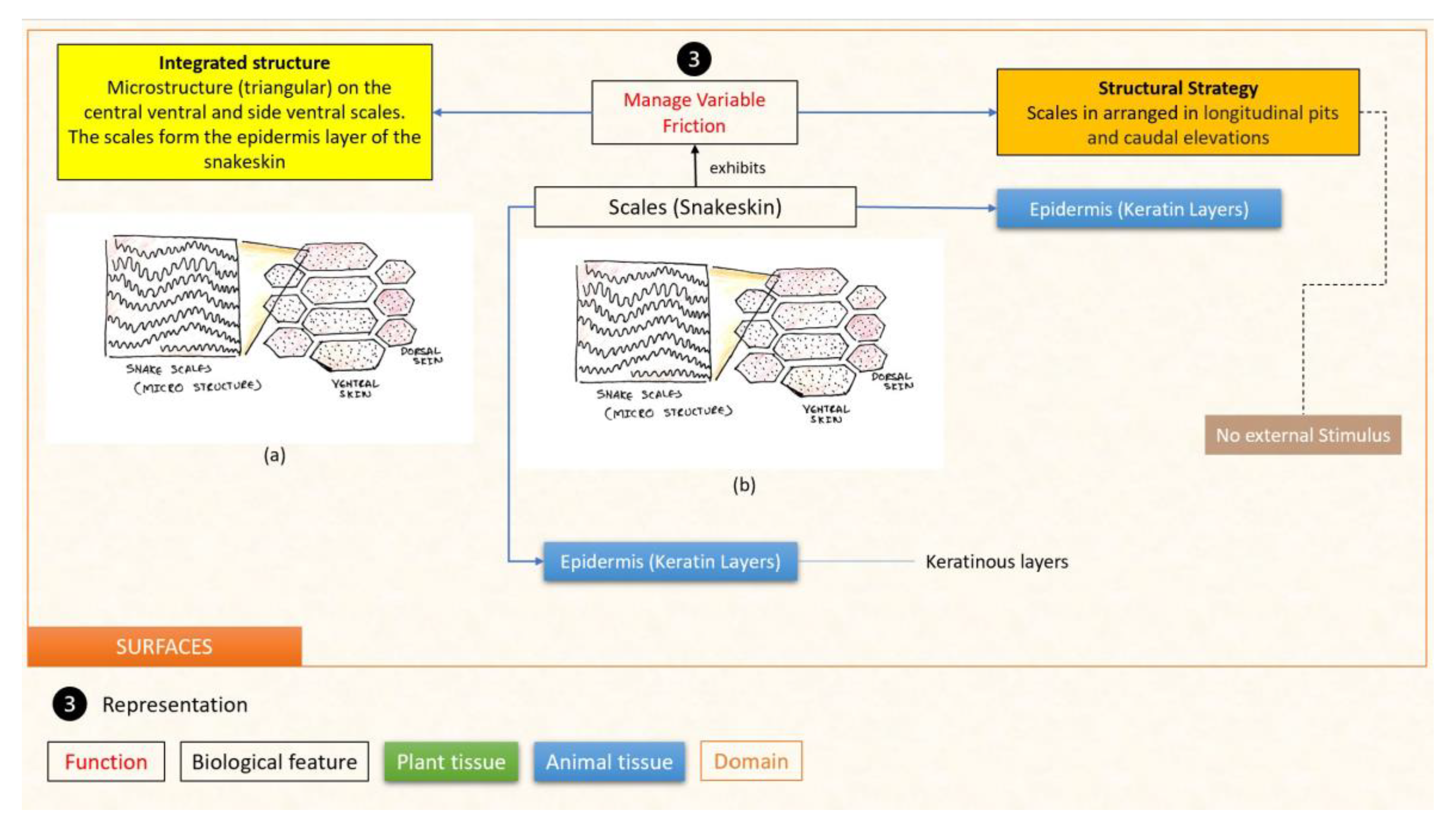

| Meta-Level Embodiment Function | Biological Feature | Biological Feature Characteristic | Integrated Structure | Structural Strategy |
|---|---|---|---|---|
| Repel water | Micro/Nano projections (Lotus Leaf) | Body/Skin Texture (Plants) | Microstructures covered with wax layers. The microstructures are often pointed in shape [13] | Random arrangement of the micro perturbances [52] |
| Resistance to erosion | Micro/Nano projections (Desert scorpion) | Body/Skin texture (Animals) | Microstructures, grooves, and bumps on the surface can improve anti-erosion performance [58] | Random arrangement of the micro bumps [58] |
Disclaimer/Publisher’s Note: The statements, opinions and data contained in all publications are solely those of the individual author(s) and contributor(s) and not of MDPI and/or the editor(s). MDPI and/or the editor(s) disclaim responsibility for any injury to people or property resulting from any ideas, methods, instructions or products referred to in the content. |
© 2023 by the authors. Licensee MDPI, Basel, Switzerland. This article is an open access article distributed under the terms and conditions of the Creative Commons Attribution (CC BY) license (https://creativecommons.org/licenses/by/4.0/).
Share and Cite
Velivela, P.T.; Zhao, Y.F. Supporting Multifunctional Bio-Inspired Design Concept Generation through Case-Based Expandable Domain Integrated Design (xDID) Model. Designs 2023, 7, 86. https://doi.org/10.3390/designs7040086
Velivela PT, Zhao YF. Supporting Multifunctional Bio-Inspired Design Concept Generation through Case-Based Expandable Domain Integrated Design (xDID) Model. Designs. 2023; 7(4):86. https://doi.org/10.3390/designs7040086
Chicago/Turabian StyleVelivela, Pavan Tejaswi, and Yaoyao Fiona Zhao. 2023. "Supporting Multifunctional Bio-Inspired Design Concept Generation through Case-Based Expandable Domain Integrated Design (xDID) Model" Designs 7, no. 4: 86. https://doi.org/10.3390/designs7040086




